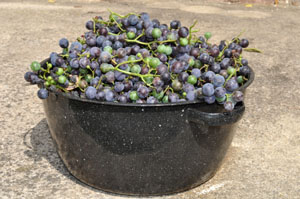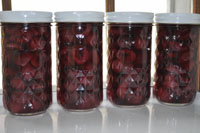Posted by · 3 Comments
Join our host, Tracy Toth, as she introduces us to a communal celebration of “all things Ag” at the Community Fair in part one of this two-part webisode.
Posted by · 3 Comments
Join our host, Tracy Toth, as she introduces us to a communal celebration of “all things Ag” at the Community Fair in part one of this two-part webisode.
Posted by · 1 Comment
 I believe sauerkraut was one of those accidental discoveries. Someone put cabbage in a vessel and just, plain, forgot about it. I’ve done that; who hasn’t? Typically, it’s something in the very back of the refrigerator though… resulting in a finale not quite as pleasant as sauerkraut.
I believe sauerkraut was one of those accidental discoveries. Someone put cabbage in a vessel and just, plain, forgot about it. I’ve done that; who hasn’t? Typically, it’s something in the very back of the refrigerator though… resulting in a finale not quite as pleasant as sauerkraut.
It’s easy to think of “kraut” being a German “discovery,” isn’t it? After all, it’s a typical pairing on a German dinner plate.
Believe it or not, the beginnings of sauerkraut actually date back a full 2,000 years—to the Chinese laborers building the Great Wall. At that time, apparently the cabbage was fermented in rice wine, whereas today we know kraut-making as a “dry method” of salting the cabbage to extract the natural juices in which it will ferment. It’s believed to have spread to present-day Europe as nomadic tribes made their way to those parts—picture Genghis Khan, plundering all the way, energized by a crock of kraut!
Captain James Cook, the 18th Century Pacific explorer, always took a store of sauerkraut on his sea voyages, since experience had taught him that it was an effective preventative of scurvy.
So, sauerkraut fed laborers who eventually crafted a man-made wonder which can be seen from space, nourished nomadic tribes as they made their way around the world, and kept sea-farers free of scurvy. Nothing in the back of my fridge could ever fuel such remarkable accomplishments… but that’s why I have sauerkraut on standby.
Posted by · 4 Comments
Our host, Tracy Toth, shares her recipe for making homemade sauerkraut in the first installment of this two-part webisode. We expect to post part two after the cabbage fermentation process concludes.
Posted by · 1 Comment
 We bade a fond farewell to our sweet corn a week ago.
We bade a fond farewell to our sweet corn a week ago.
Nothing, and I mean nothing, beats the taste of a freshly picked ear of sweet corn.  My husband always plants the old standby “Silver Queen.” It’s been a popular variety with farmers for decades and has a maturity of 92 days. This year, we also planted “Bodacious” which has a 75-day maturity and “Delectable” with an 84-day maturity. The different days to maturity as well as staggered plantings, allow for a sweet corn harvest over several summer weeks if you’re a savvy planter!
My husband always plants the old standby “Silver Queen.” It’s been a popular variety with farmers for decades and has a maturity of 92 days. This year, we also planted “Bodacious” which has a 75-day maturity and “Delectable” with an 84-day maturity. The different days to maturity as well as staggered plantings, allow for a sweet corn harvest over several summer weeks if you’re a savvy planter!
I’ve frozen corn in the past by cutting it from the cob, blanching it, and securing in freezer bags. I’ve even canned it—which is fairly time-consuming because of the processing time in the pressure canner. The best way to enjoy it, though, is right out of your garden, right out of the pot, and  right off the cob!
right off the cob!
Parting is such sweet sorrow…
Posted by · Leave a Comment
 I’ll tell you: make one and a half quarts of grape juice and two batches of grape jelly, that’s what.
I’ll tell you: make one and a half quarts of grape juice and two batches of grape jelly, that’s what.
I don’t know what kept me from making jelly years ago. When I first started canning, I was drawn toward the jams because it was just a matter of squishing everything up and adding sugar and pectin. I was so proud! But, then, came the turned-up noses of two toddlers to the texture of the fruit and jelly—who knew? The following year, I relented and began making jelly. WHAT A SNAP?! Why was I intimidated? What was I thinking?
started canning, I was drawn toward the jams because it was just a matter of squishing everything up and adding sugar and pectin. I was so proud! But, then, came the turned-up noses of two toddlers to the texture of the fruit and jelly—who knew? The following year, I relented and began making jelly. WHAT A SNAP?! Why was I intimidated? What was I thinking?
 Jelly is now my preferred route of fruit preservation. I usually drip the mashed fruit overnight to collect the juice and then make the jelly, first-thing, the next morning. However, it seemed the grapes were pouring their juice through the jelly bag yesterday so I was able to make it the same day… make two batches… and collect more than a quart of juice.
Jelly is now my preferred route of fruit preservation. I usually drip the mashed fruit overnight to collect the juice and then make the jelly, first-thing, the next morning. However, it seemed the grapes were pouring their juice through the jelly bag yesterday so I was able to make it the same day… make two batches… and collect more than a quart of juice.
And there are four times as many grapes left on the vines!
Posted by · Leave a Comment
 When you can fruits or veggies, you hope for the best…the best quality, the best “seal,” the best (and prettiest) presentation or “pack.”
When you can fruits or veggies, you hope for the best…the best quality, the best “seal,” the best (and prettiest) presentation or “pack.”
 Sometimes, everything comes together on the very first go-round – like the Ball recipe for Spirited Cherries I attempted for the first time yesterday.
Sometimes, everything comes together on the very first go-round – like the Ball recipe for Spirited Cherries I attempted for the first time yesterday.
 So very delicious…and simple…and pretty…that I just had to do a second batch immediately! These will be a perfect addition to a main course or dessert, especially in the winter when you seek out those bolder flavors.
So very delicious…and simple…and pretty…that I just had to do a second batch immediately! These will be a perfect addition to a main course or dessert, especially in the winter when you seek out those bolder flavors.
Yesterday, I was bemoaning the fact I did not have a cherry pitter. De-stoning 18 cups of cherries “by hand” with my trusty paring knife was tedious, yet it resulted in a much prettier presentation!
Posted by · Leave a Comment
When I began canning, years ago, I was amazed to find preserving fruits and veggies wasn’t just “pickles and jellies.” In the years since then, I’ve collected and used many recipes stretching from marmalades to desserts!
The conserve is so versatile, one can use it as a spread on your toast in the morning or a topping on your cheesecake after dinner (or, like I prefer, with a little chevre).  There are usually a few different flavors “going on” in the jar, regardless of the fruit you’ve used for the conserve.
There are usually a few different flavors “going on” in the jar, regardless of the fruit you’ve used for the conserve.
The deep blue of the blueberry doesn’t allow us to see the lemon and orange rings that are part of the recipe – which is a shame because that makes for a lovely presentation. I’ll get over that though….I have to; there’s only one jar left!
Posted by · Leave a Comment
Posted by · 1 Comment
We had an abundance of currants this year–so many that I was able to make both Bar-Le-Duc (currant preserves) and currant jelly.
 Bar-Le-Duc is a highly-prized accompaniment but I was surprised to learn that currant jelly is regarded as “lower cost and quality.”
Bar-Le-Duc is a highly-prized accompaniment but I was surprised to learn that currant jelly is regarded as “lower cost and quality.”
To make a jelly, one must extract the juice and then the juice is combined with other ingredients. No small feat with currants, which are not the juiciest of fruits!
I find the Bar-Le-Duc and the currant jelly very satisfying. Maybe my palate needs an upgrade? I think not. I’ll continue to enjoy them both. Equally.
Posted by · 4 Comments